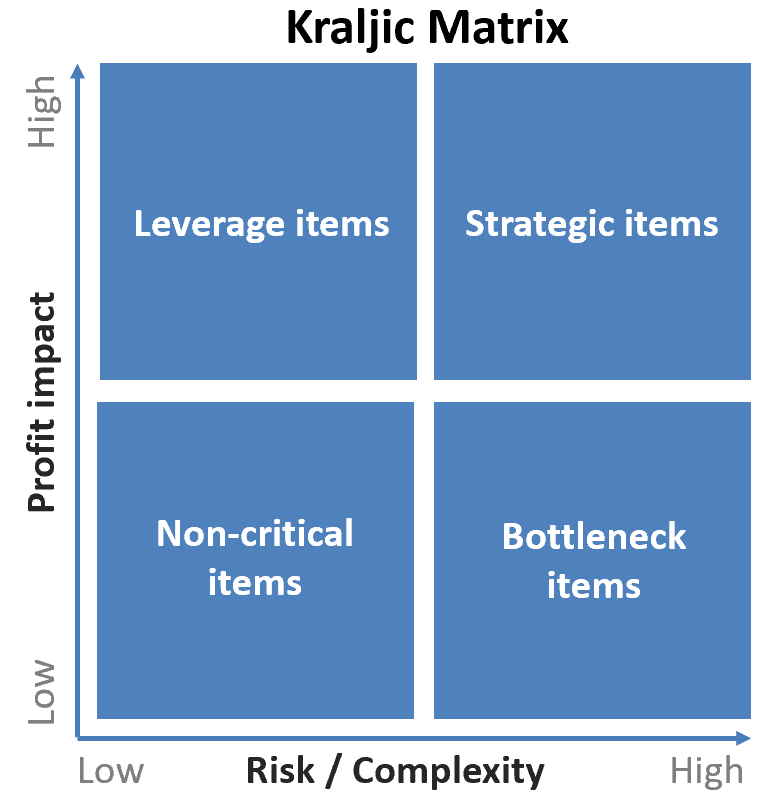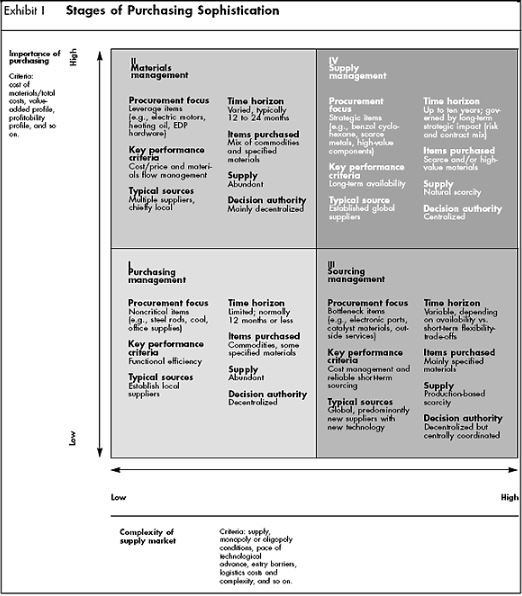I am by no means an expert on the Kraljic matrix. I could ramble about it for about 3 minutes, and you would not understand a word. This is why you have in the Sources and Links section the link to the complete article from the author itself.
What I do know, and would like to share with you, is how to use it.
But, let us learn one more principle before. It is called the Pareto principle or Pareto rule. It was a rule first used in mathematics, but soon people figured out that it applies in almost any area of life. Basically, he said that 80% of the results come from 20% of the activities. Translated into procurement, it means that we get 80% of the purchase value from 20% of our largest suppliers. And I can tell you from my experience that this is more-less true.
The Kraljic matrix is the tool that helps us to determine the 20% we need to focus on, accurate and quick. As per the Kraljic matrix, we segregate suppliers based on 2 criteria: Importance (profit impact) and complexity.

Profit impact is determined by the total annual value of the purchased material. Be aware, total value. We have expensive items that we buy in small quantities and cheap items that we buy in bulk.
Complexity concerns market conditions. Is the item a commodity or standardized? Are there many suppliers available or is it a custom-made item patented by one producer? Maybe new technology that only a couple of suppliers have mastered so far? How can logistics be organized?
We can use a scale system from 1-10 or simply grade it as important/not important and complex / not complex. Once this is done, all products will fit into one of the four groups in the matrix.
Leverage items
High importance, low complexity. We buy a high volume/value of the item, and the item is widely available from multiple sources. Hence, our focus is on price and availability. We leverage our purchasing power to do so.
Strategic items
High importance, high complexity. These are the ones we need to focus on. Strategic items require a strategic approach. Long term contracts, partnerships, even joint ventures. The main goal is to assure product availability. These suppliers need to be kept very close and with an open communication channel. If this is not done you will find yourself in the position Ericsson was when their only supplier of microchips stopped production due to fire (more in my post: Famous Supply Chain disasters).
Non-critical items
Low importance and low complexity. Do not spend too much time here. Create a process, arrange the deliveries with local suppliers. Even, if possible, let them manage your inventory. The goal here is just to get it in as efficient as possible.
Bottleneck items
Low importance, high complexity. These are items that are not of high value, yet difficult to get. Quite often we will find in this group equipment spare parts or specialized services. The goal here is to get it done. For items where a regular supply is not required contracting may not be an option. So, we will need to be able to react and in the short term get the goods.
Sorted by importance the matrix would be: Strategic, Leverage, Bottleneck, Non-critical. Once the segregation is done, make a strategy for each group and move ahead with the execution. We should do an annual revision of the matrix, or at any major change in the production. Especially the complexity can change due to the entrance of new suppliers or technological advancements.
This is the Kraljic matrix in short. Remember the 80/20 and always focus on the 20%.


